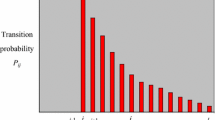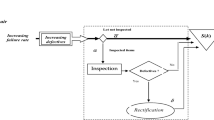Abstract
Performance of machine tool tends to deteriorate in the production process. This deterioration increases the processing energy consumption and leads to more defectives and corresponding energy waste. Maintenance can be taken to restore the performance of machine tool and improve the energy efficiency, which has a significant impact on the total energy consumption and productivity. This paper proposes an approach to improve the energy efficiency of the production process through scheduling the maintenance actions of the machine tool, taking into account productivity, product quality, and energy consumption. The deteriorating machine tool is modeled as a discrete-time, discrete-state Markov process. Partially observable Markov decision process (POMDP) framework is applied to develop the maintenance decision-making model, where the joint observation of processing energy consumption and quality of manufactured workpiece is used to infer the status of the machine tool. An optimal maintenance policy maximizing the total expected reward about energy efficiency over a finite horizon is obtained, which consists of a sequence of decision rules corresponding to the optimal action for each belief vector. The characteristics of the optimal policy are illustrated through a numerical example and the effects of parameters on the policy are analyzed.
Similar content being viewed by others
References
Abdelaziz EA, Saidur R, Mekhilef S (2011) A review on energy saving strategies in industrial sector. Renew Sust Energ Rev 15(1):150–168
Liu F, Wang Q, Liu G (2013) Content architecture and future trends of energy efficiency research on machining systems. J Mech Eng(49)19:87-94 (in Chinese)
Oda Y, Mori M, Ogawa K, Nishida S, Fujishima M, Kawamura T (2012) Study of optimal cutting condition for energy efficiency improvement in ball end milling with tool-workpiece inclination. CIRP Ann Manuf Technol 61(1):119–122
Shao H, Wang H, Zhao X (2004) A cutting power model for tool wear monitoring in milling. Int J Mach Tools Manuf 44(14):1503–1509
Xu M (2007) Smart machining system platform for cnc milling with the integration of a power sensor and cutting model. Dissertation, University of New Hampshire
Xuan Z, Lu C (2009) Analysis on tool wear and cutting force of Si3N4 diamond coated tools in high speed machining. Mach Tool Hydr 37(11):45-48 (in Chinese
Dietmair A, Verl A (2009) A generic energy consumption model for decision making and energy efficiency optimisation in manufacturing. Int J Sustain Eng 2(2):123–133
Drake R, Yildirim MB, Twomey J, Whitman L, Ahmad J, Lodhia P(2006)Data collection framework on energy consumption in manufacturing. In: IIE Annual Conference and Exposition, Orlando, Florida, USA
Gutowski T, Dahmus J, Thiriez A (2006) Electrical energy requirements for manufacturing processes. In: 13th CIRP International Conference on Life Cycle Engineering, Leuven, Belgium
Spaan MT, Vlassis N (2005) Perseus: randomized point-based value iteration for POMDPs. J Artif Intell Res 24:195–220
Diaz N, Choi S, Helu M, Chen Y, Jayanathan S, Yasui Y, Kong D, Pavanaskar S, Dornfeld D (2010). Machine tool design and operation strategies for green manufacturing. In: Proceedings of 4th CIRP International Conference on High Performance Cutting, Gifu, Japan, 271–276
Kroll L, Blau P, Wabner M, Frieß U, Eulitz J, Klärner M (2011) Lightweight components for energy-efficient machine tools. CIRP J Manuf Sci Technol 4(2):148–160
Rajemi MF, Mativenga PT, Aramcharoen A (2010) Sustainable machining: selection of optimum turning conditions based on minimum energy considerations. J Clean Prod 18(10):1059–1065
Mori M, Fujishima M, Inamasu Y, Oda Y (2011) A study on energy efficiency improvement for machine tools. CIRP Ann Manuf Technol 60(1):145–148
Hu S, Liu F, He Y, Hu T (2012) No-load energy parameter characteristics of computerized numerical control machine tool main transmission system. Comput Integr Manuf Syst 18(2):26–31
Mouzon G, Yildirim MB, Twomey J (2007) Operational methods for minimization of energy consumption of manufacturing equipment. Int J Prod Res 45(18–19):4247–4271
Shi J, Liu F, Xu D, Chen G (2009) Decision model and practical method of energy-saving in nc machine tool. Chin Mech Eng 20(11):1344-1346( in Chinese)
Shrouf F, Ordieres-Meré J, García-Sánchez A, Ortega-Mier M (2014) Optimizing the production scheduling of a single machine to minimize total energy consumption costs. J Clean Prod 67:197–207
Chen G, Zhang L, Arinez J, Biller S (2013) Energy-efficient production systems through schedule-based operations. IEEE Trans Autom Sci Eng 10(1):27–37
Cao H, Tao X, Liu F (2010) An energy saving scheduling model for machine tools and its application. Mech Sci Tech 29(6):744–748 (in Chinese)
Xu W, Cao L (2014) Energy efficiency analysis of machine tools with periodic maintenance. Int J Prod Res 52(18):5273–5285
Smallwood RD, Sondik EJ (1973) The optimal control of partially observable markov processes over a finite horizon. Oper Res 21(5):1071–1088
Papakonstantinou KG, Shinozuka M (2014a) Optimum inspection and maintenance policies for corroded structures using partially observable markov decision processes and stochastic, physically based models. Probab Eng Mech 37:93–108
Anily S, Grosfeld-Nir A (2006) An optimal lot-sizing and offline inspection policy in the case of nonrigid demand. Oper Res 54(2):311–323
Ivy JS, Pollock SM (2005) Marginally monotonic maintenance policies for a multi-state deteriorating machine with probabilistic monitoring, and silent failures. IEEE Trans Reliab 54(3):489–497
Meola G (2007) Bayes-optimal control policy for a deteriorating machine based on continuous measurements of the manufactured parts. Dissertation, Polytechnic University of Milan
AlDurgam MM, Duffuaa SO (2009) Maximizing overall system effectiveness (OSE) for three-state, partially observable system. In: Proceedings of the third international conference on modeling, simulation and applied optimization, Sharjah, UAE, 20–22 January
AlDurgam MM, Duffuaa SO (2013) Optimal joint maintenance and operation policies to maximise overall systems effectiveness. Int J Prod Res 51(5):1319–1330
Chiang JH, Yuan J (2001) Optimal maintenance policy for a markovian system under periodic inspection. Reliab Eng Syst Saf 71(2):165–172
Ben-Zvi T, Grosfeld-Nir A (2013) Partially observed markov decision processes with binomial observations. Oper Res Lett 41(2):201–206
Le MD, Tan CM (2013) Optimal maintenance strategy of deteriorating system under imperfect maintenance and inspection using mixed inspection scheduling. Reliab Eng Syst Saf 113:21–29
Bertsekas DP, Tsitsiklis JN (2008) Introduction to probability, 2nd edn. Athena Scientific, Belmont
Xu W, Cao L (2015) Optimal tool replacement with product quality deterioration and random tool failure. Int J Prod Res 53(6):1736–1745
Papakonstantinou KG, Shinozuka M (2014c) Planning structural inspection and maintenance policies via dynamic programming and markov processes. Part II: POMDP implementation. Reliab Eng Syst Saf 130:214–224
Thiede S (2012) Energy efficiency in manufacturing systems. Springer, Dordrecht
Papakonstantinou KG, Shinozuka M (2014b) Planning structural inspection and maintenance policies via dynamic programming and markov processes. Part I: theory. Reliab Eng Syst Saf 130:202–213
Author information
Authors and Affiliations
Corresponding author
Rights and permissions
About this article
Cite this article
Xu, W., Cao, L. Optimal maintenance control of machine tools for energy efficient manufacturing. Int J Adv Manuf Technol 104, 3303–3311 (2019). https://doi.org/10.1007/s00170-018-2233-1
Received:
Accepted:
Published:
Issue Date:
DOI: https://doi.org/10.1007/s00170-018-2233-1




